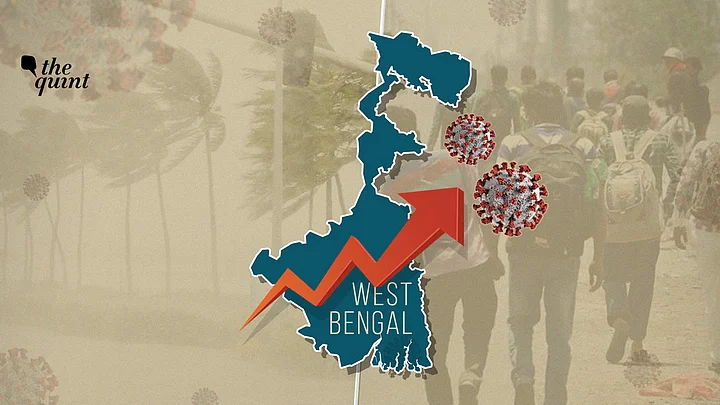On 20 May, as West Bengal recorded 3,103 COVID-19 cases, a devastating cyclone, Amphan, ravaged through the state.
Just three days before that, one of the first Shramik special trains carrying migrants from Mumbai, chugged into Howrah station. As of 4 June, the number of COVID cases in the state stand at 6,876.
While this rise in the case positivity rate can be attributed to the significant rise in the state’s testing rates, certain indicators also point towards factors exacerbated by Amphan and the influx of migrants, which could be a cause of concern.
Influx of Migrants Affecting Rural Areas
A look at district-wise COVID data from the state, gives an insight into how the influx of migrants may have affected COVID numbers.
As of 17 May, districts like Murshidabad, Malda and Nadia, which subsequently saw many migrants returning, had 9, 25 and 12 positive COVID cases respectively.
The total number of positive cases in the state, at this juncture, was 2,677. The number of tests being conducted by the state per day stood at 8,668.
Compare this to figures from 4 June, after over 8.5 lakh migrants (according to the government) had returned to the state from states like Maharashtra, Gujarat and Tamil Nadu. Murshidabad has now recorded 108 cases, Nadia 110 and Malda 158. This, while the number of tests per day, at 9,606 and has not increased as drastically in proportion as the number of increase in cases.
A report by The Hindustan Times on 27 May, states, citing health ministry sources, that most cases found positive in rural Bengal were that of migrants, most of whom were asymptomatic.
This comes in the backdrop of the Mamata Banerjee government in West Bengal receiving severe criticism for “not allowing” migrants back into the state. Railways Minister Piyush Goyal had stated earlier that nearly 30 lakh migrants from West Bengal were stuck across the country since the lockdown. The West Bengal government, has of course, denied this charge.
“What is also causing problems in the rural areas is that many migrants who are asymptomatic and are being put in isolation are fleeing detention centres as they want to stay at home after travelling so far”, said a Nadia district functionary of the Trinamool Congress on condition of anonymity.
“The increase in number in West Bengal is not because more cases are happening now. These are cases which were already positive and received transmission elsewhere. They are getting tested now and being declared positive here”, says Dr. Pritam Roy, an epidemiologist and public health specialist in Kolkata.
“It won’t be proper to allow all stranded migrant labourers to step in at one go. They need to be brought back in phases as detailed planning needs to be made for screening and testing”, says Roy.
The idea of a phased influx of migrants has also been proposed by the state government, citing the exact same reason.
The Double Whammy Of Amphan
As has been written about over and again, cyclone Amphan seemed to have pushed West Bengal’s COVID efforts five steps back. According to government sources, the biggest challenge post-Amphan was housing the homeless and the COVID infected at the same time. Many cyclone relief centres in the state, which had earlier been converted into COVID isolation camps, have now had to be brought back for cyclone relief and houses Amphan victims now.
Add to that the fact that many migrant labourers returning home were now left with no homes and therefore no option to isolate. As the relief camps get crowded, there is also the apprehension that the cyclone has washed away all fears of COVID from the minds of the people.
“The cyclone has put social distancing out of consideration, which is a very worrisome trend”, says Dr. Roy. “If they (the migrants) are not detected then they will go home and transmit it to their partners, children and older parents who may develop complications or die. Besides COVID, other cases like malaria, dengue and kala-azar may also be transmitted during this time. Such an epidemiological shift always amplifies diseases”, he adds.
Between 20 and 26 May, Shramik Special trains coming into West Bengal had been stopped due to requests by the state government which wanted to focus on recovery work for Amphan and stated that it was not prepared to handle migrants coming in at that point.
The trains were started again from 27 May. According to the state government’s estimates, 10.5 lakh people will be back in the state by 10 June.
Meanwhile, West Bengal recorded over 300 positive cases, the highest in days, for three consecutive days on 4 June. The last 1,000 cases in the state took 4 days.
(At The Quint, we question everything. Play an active role in shaping our journalism by becoming a member today.)
